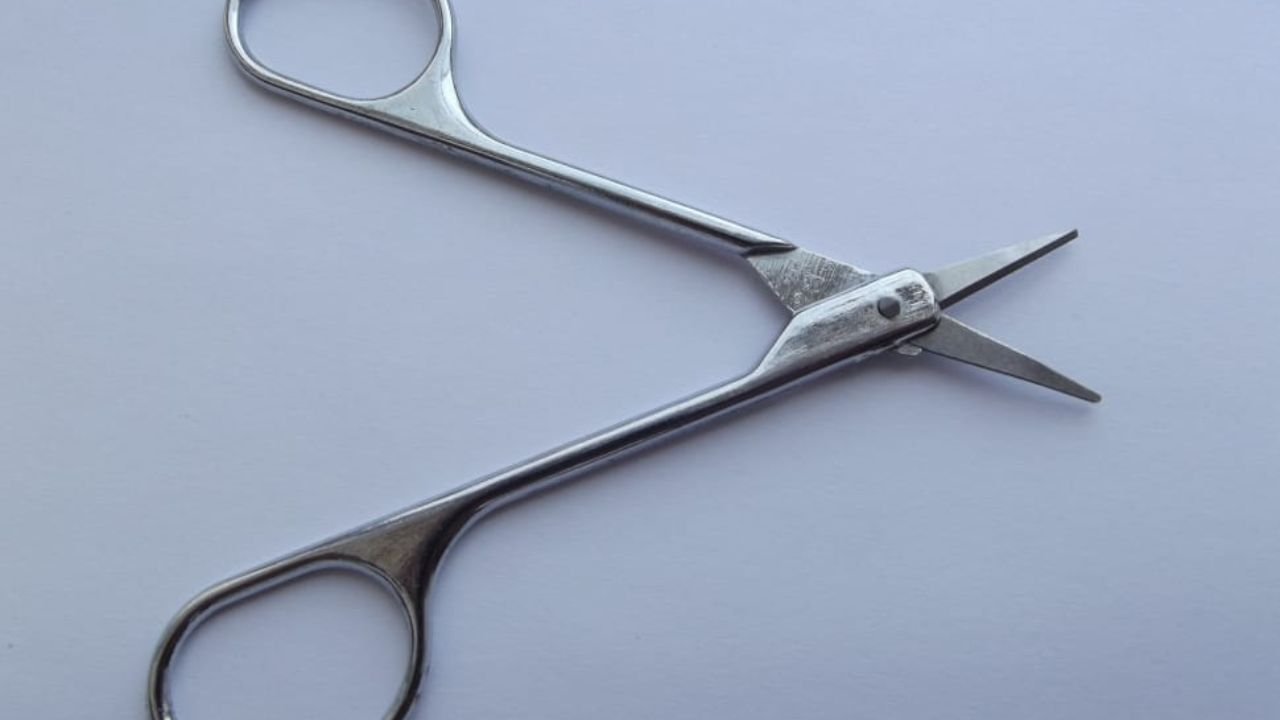Can You Bring Needlepoint Scissors On A Plane? Yes, you can bring needlepoint scissors on a plane, provided their blades are less than 4 inches from the pivot point. This applies to most small embroidery scissors and snips.
If you’re an avid crafter, especially a needlepoint enthusiast or embroidery lover, you might find yourself needing to bring your tools along when traveling. But one question that often pops up is: Can you bring needlepoint scissors on a plane?
Traveling with crafting supplies, especially scissors, can be tricky due to airport security regulations. Whether you’re heading on a vacation, business trip, or a stitching retreat, understanding the rules around bringing needlepoint scissors on a plane is essential.
In this article, we’ll break down everything you need to know to ensure your needlepoint scissors make it through airport security without issue. From TSA guidelines to packing tips, we’ll cover it all.
Contents
- 1 TSA Guidelines on Scissors
- 2 What Type of Scissors Are Allowed?
- 3 Size Limitations: What You Need to Know
- 4 Packing Tips: How to Get Through Security Without a Hitch
- 5 Items That Can’t Be Brought
- 6 Checked Luggage Option
- 7 Exceptions and Airline Policies
- 8 Conclusion: Can You Bring Needlepoint Scissors On A Plane ?
- 9 FAQs
- 9.1 1. Can I bring large embroidery scissors on a plane?
- 9.2 2. What happens if I try to bring scissors with blades longer than 4 inches in my carry-on?
- 9.3 3. Are needlepoint scissors considered a security risk?
- 9.4 4. Can I bring circular thread cutters or other small sewing tools in my carry-on?
- 9.5 5. Are there any special considerations for international flights?
TSA Guidelines on Scissors
The first thing you should know is that the Transportation Security Administration (TSA) has specific rules regarding sharp objects, including scissors, in carry-on luggage. While these regulations apply to all passengers, they are particularly relevant for crafters who may want to carry small scissors like needlepoint or embroidery tools.
In general, the TSA allows small scissors in carry-on luggage as long as they meet the size restrictions. Specifically, scissors with blades less than 4 inches from the pivot point are permitted.
That’s the key – the length of the blade from the point where the blades meet, not the total length of the scissors. This is why most small needlepoint or embroidery scissors are usually acceptable, as they often fall within this size range.
What Type of Scissors Are Allowed?
When packing your needlepoint scissors, it’s crucial to know which types of scissors are likely to be allowed. As mentioned earlier, TSA regulations focus on the blade length, not the style or type of scissors. Here are some examples of scissors commonly used for needlepoint and embroidery, and their likelihood of making it through security:
- Small Embroidery Scissors: These are usually compact and have very short blades, making them well within the TSA size restriction. Typically, these scissors are around 3 to 4 inches long, so you shouldn’t encounter issues bringing them in your carry-on bag.
- Needlepoint Scissors: Similar to embroidery scissors, needlepoint scissors tend to be small with fine, sharp tips. As long as the blades are under 4 inches, these are usually allowed.
- Thread Snips: Often smaller than regular scissors, thread snips are commonly used by crafters to cut thread and fabric. These typically meet the TSA guidelines, but it’s always worth double-checking their blade length.
However, it’s important to note that larger scissors designed for cutting fabric or heavy materials may not meet the size restrictions. These are more likely to be flagged during the security check and may need to be packed in your checked luggage.
Size Limitations: What You Need to Know
Now that you’re familiar with the types of scissors that can usually make it through airport security, let’s talk about the size limitations that are the key to understanding what you can carry on a plane.
- Blade Length: Scissors with blades shorter than 4 inches from the pivot point are generally allowed. This means that most needlepoint scissors, which typically have small, sharp blades, will comply with TSA’s rules.
- Total Length: TSA doesn’t specifically restrict the total length of scissors, but as mentioned, it’s the blade length that matters. If the blades of your scissors are less than 4 inches, it doesn’t matter how long the handles are, and they should pass through security without a problem.
For reference, here’s an example: If you have a pair of embroidery scissors where the entire length is 5 inches, but the blade itself is just 3 inches long, the scissors should still be fine for carry-on luggage.
Packing Tips: How to Get Through Security Without a Hitch
While TSA allows scissors that meet the size restrictions, there are still ways you can prepare to ensure a smoother security experience. Here are some packing tips to help you navigate the airport with your crafting tools:
- Keep Scissors Easily Accessible: When packing your carry-on bag, try to place your scissors in an easily accessible spot. This way, you can quickly pull them out if security agents ask to inspect them. Having everything ready to show can help speed up the process.
- Use a Protective Case: To avoid accidentally cutting yourself or causing alarm when your bag is scanned, it’s a good idea to place your scissors in a protective case. You can use a small hard case or a fabric pouch that zips closed. This adds an extra layer of security for both you and the security staff.
- Pack Scissors in a Separate Bag: If you’re carrying other sharp objects, such as knitting needles or other small tools, try to keep your scissors in a separate compartment. This will help security officers easily identify the scissors without having to sift through your entire bag.
- Know the Rules: Before you head to the airport, make sure you’ve reviewed the TSA’s official guidelines regarding sharp objects. The last thing you want is to be caught off-guard by an unexpected issue at security.
Items That Can’t Be Brought
While small scissors are generally allowed in your carry-on bag, there are certain scissors and cutting tools that are not allowed on a plane, and it’s essential to know which ones to avoid. Here are some items you cannot bring on board in your carry-on luggage:
- Scissors with Blades Longer than 4 Inches: These are considered a security risk and are not allowed in carry-on bags. If you have larger scissors, make sure to pack them in your checked luggage.
- Circular Thread Cutters: Although these are handy tools for crafters, they typically contain small blades and may not pass through security in carry-on luggage.
- Sharp Cutting Tools: Other tools that have sharp blades, such as large rotary cutters or shears, should be placed in checked luggage. If in doubt, check with TSA before traveling.
Checked Luggage Option
If your scissors exceed the 4-inch blade length limit or if you simply want to avoid any issues at the security checkpoint, you can always pack your scissors in your checked luggage. While it may take longer to retrieve your tools once you land, you’ll have peace of mind knowing that you won’t run into problems with TSA regulations.
For larger or more specialized scissors, such as those used for cutting fabric or heavy materials, packing them in your checked bag is your best bet. Keep in mind that checked luggage is generally not subject to the same size restrictions as carry-on bags, so you don’t have to worry about blade length here.
Exceptions and Airline Policies
While TSA provides the general guidelines for what’s allowed on planes, it’s always worth checking with your airline before you travel. Some airlines may have additional or more restrictive policies when it comes to carry-on luggage, including the types of scissors allowed.
For instance, certain international flights may have stricter rules on carrying sharp objects, so it’s always a good idea to check the regulations of the country you’re flying to or from. Some airlines may also have specific guidelines for carrying craft supplies, so it’s worth confirming ahead of time to avoid any surprises.
Conclusion: Can You Bring Needlepoint Scissors On A Plane ?
Traveling with needlepoint scissors doesn’t have to be stressful if you know the rules and plan ahead. As long as your scissors have blades under 4 inches from the pivot point, they should make it through TSA security without issue. For larger tools, it’s best to pack them in your checked luggage.
By following the TSA guidelines, packing your scissors safely, and being mindful of any airline-specific rules, you can enjoy your crafting while traveling without worrying about confiscated tools.
So the next time you’re heading out on a trip, don’t forget to pack your needlepoint scissors—just make sure they’re the right size! Happy stitching!
FAQs
1. Can I bring large embroidery scissors on a plane?
Large embroidery scissors, or any scissors with blades longer than 4 inches, are not allowed in carry-on luggage. If your embroidery scissors exceed this length, it’s best to pack them in your checked luggage.
2. What happens if I try to bring scissors with blades longer than 4 inches in my carry-on?
If you attempt to bring scissors with blades longer than 4 inches in your carry-on bag, TSA agents will likely confiscate them. To avoid this, ensure your scissors comply with the size limit or pack them in checked luggage.
3. Are needlepoint scissors considered a security risk?
Needlepoint scissors, typically small and sharp, are not generally considered a security risk as long as they meet the TSA’s blade length requirement. Always double-check the size of your scissors before traveling.
4. Can I bring circular thread cutters or other small sewing tools in my carry-on?
Circular thread cutters and other sharp tools, like some specialized sewing cutters, may not be allowed in carry-on luggage due to their blade design. It’s better to place these in checked luggage.
5. Are there any special considerations for international flights?
International flights may have different rules and regulations regarding carry-on items. Always check with your airline or the relevant airport authorities to ensure your needlepoint scissors meet the security standards of the country you’re flying to or from.

Hello, I’m Janiyah Gibbs—a retired flight crew member and former TSA officer from Alaska, USA. At PlaneCarry.com, I share expert insights on what to carry (and avoid) when flying.

